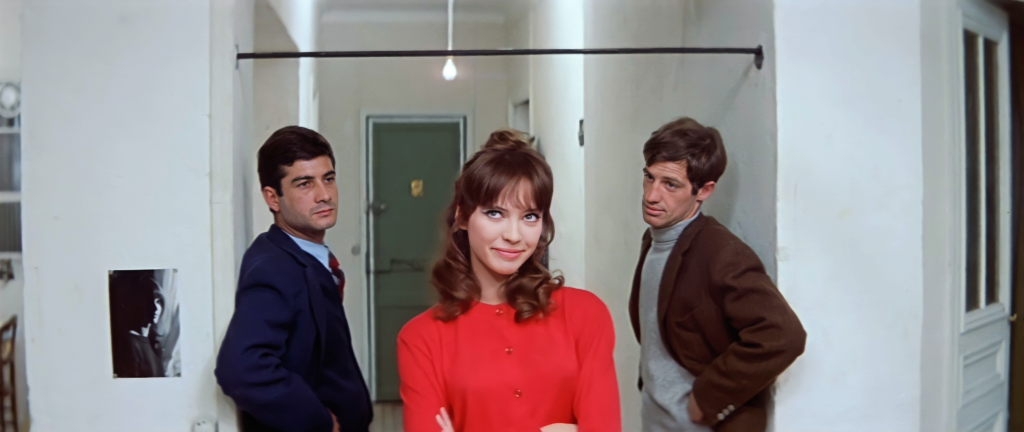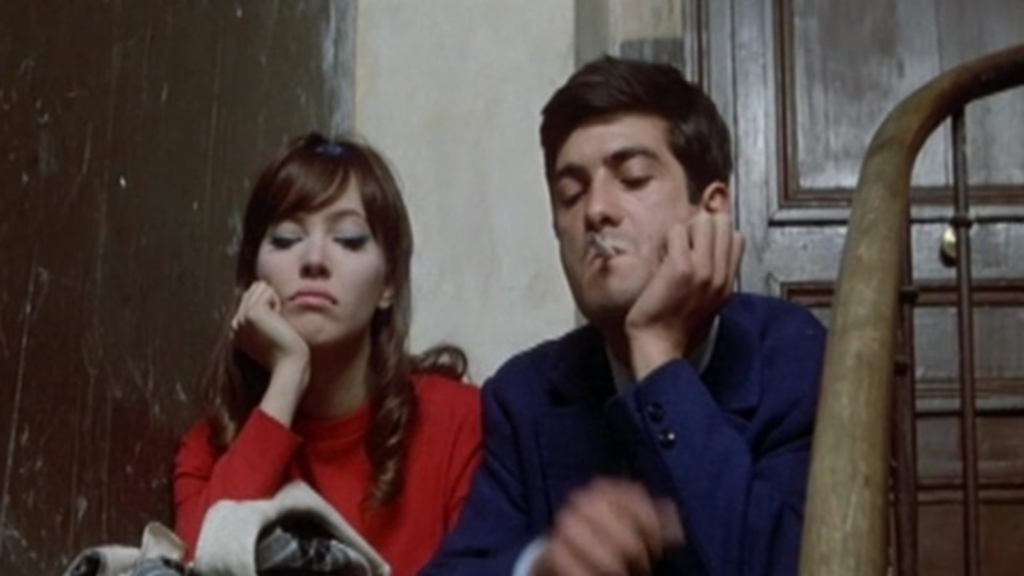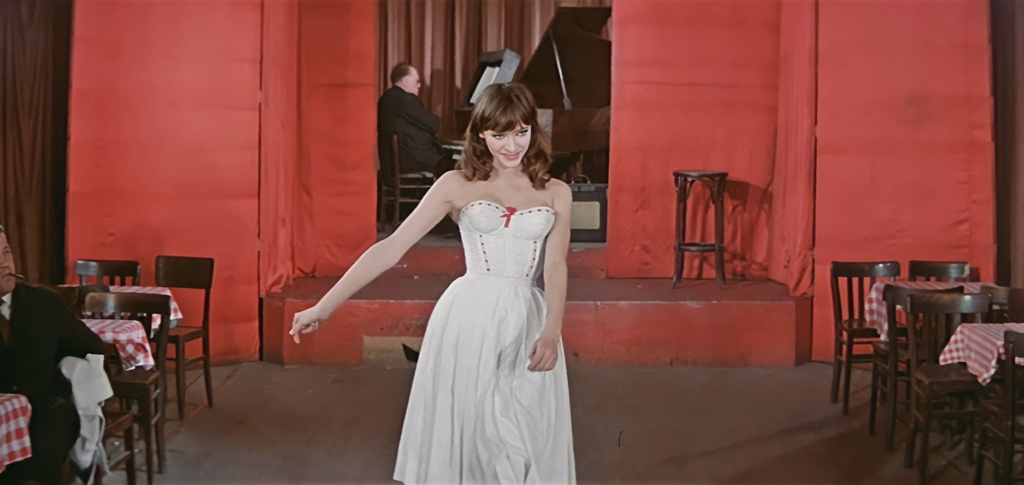Director: Jean-Luc Godard
Writers: Geneviève Cluny, Jean-Luc Godard
Stars: Anna Karina, Jean-Claude Brialy, Jean-Paul Belmondo
Synopsis: An exotic dancer is desperate to become a mother and accepts her reluctant boyfriend’s suggestion that she be impregnated by his best friend.
What else can be said of Jean-Luc Godard, the influential French-Swiss cinema legend and pioneer of one of the most significant film movements of all time in the French New Wave? He is more than a recognizable figure in the medium. The man has sculpted pieces that will stand the test of time in ways that few filmmakers would. Thousands have discussed his work on podcasts and think pieces. Hundreds have written books about his importance and contributions to cinema. And millions have ventured into his eclectic, occasionally cryptic filmography, basking in his ingenuity and knack for breaking the mold of narrative cinema as we know it. Innovation is a certain compulsion for Godard, who drives himself mad to give audiences vastly different cinematic experiences, both intellectually and artistically.

After introducing himself to the film world with the revolutionary work that many hold in high regard in 1960, Breathless, he decided to do his spin on American musicals, but with his usual dry wit and societal commentary in his third feature, A Woman is a Woman (Une Fumme est une Femme)–and a new 4K restoration is having its world premiere in the Piazza Grande at this year’s Locarno Film Festival. Made from the negative 35mm original copy, a new life is breathed into the 1961 film. It looks better and sounds crisper than before. But the most important aspect of A Woman is a Woman receiving a restoration is how modern audiences can now have a proper glimpse and think about its notions of gender roles and relationships across the ages presented in the film, which is, in my books, one of Godard’s best.
Jean-Luc Godard’s neorealist musical centers around an exotic dancer named Angela (Anna Karina, at the height of her career) who yearns to have a child sooner rather than later. But her partner, Emile (Jean-Claude Brialy), does not want to settle down with her just yet. Emile wants to live free of any burden or hassle while young and without many preoccupations. Angela has tried many times to convince him to give her a child. She grows piqued that the man she loves is not making any sacrifices in their relationship. Even though the two share many charming, joyous moments, that dark cloud is still above their heads.

In her performance, Anna Karina offers a mixture of emotions as the events of A Woman is a Woman unfold. But during the initial strand, she uses the blend of joy and anguish–both a mask and the genuine feeling in her soul. You can see both easily as Godard places her at the forefront of each frame, swallowing the canvas in her lonely wallows and the audience’s empathy for the young woman. Each argument the lead characters have about their reasonings behind having a child or not at that particular time has the French-Swiss director exploring, in his own unique way, how all of us are emotionally foolish and irrational, with love being the anchor to our various woes, bliss, and everything in-between.
They are unable to rationalize with one another. It isn’t until the very end of the film that Angela and Emile come to some sort of understanding. And still, the two clash due to their nature and naivety. We see them call each other names, forcing one to subject themselves to their sexes’ stereotypes, and question their reasonableness on not just love but the sacrifice that comes with having an intimate relationship with a person. All of this escalates upon the arrival of a third member to the party, Emile’s best friend and neighbor, Alfred (Jean-Paul Belmondo). He is one of the many men vastly in love with Angela. The difference is that he sees more in her than the others, at least in comparison. Alfred is still a man with many flaws and unreasonable deductions concerning love.
With the three leading players now in the mix, Godard plays his trump card in A Woman is a Woman. He raises questions about women’s social roles (specifically seen through the lens of sex work), the difference between men and women in society, and how love blinds. What differentiates Godard from other filmmakers is that he never intends to answer the questions he raises nor provides his thoughts on them. He is known for his pretentiousness, which annoys me from time to time. But I admire his tenacity in making the audience think–they ponder about similar situations in their societies and compare them to the one being depicted. In this case, Godard covers early ‘60s France via three lovebirds trying to understand each other and come to a prosperous resolution, failing to communicate in each standing moment.

No matter the time or place, the dynamics between Angela, Alfred, and Emile are translated into each generation and society, yet with a change in their political backbone and philosophies. Ultimately, this story is replicated, whether it happened to someone else or yourself. Not many works in his filmography contain those elements of empathetic, universal comprehension. Later in his career, during the ‘80s and beyond, he started drifting into a more portentous territory. But in the ‘60s, Godard created many rich, detailed stories that were universal to them. Godard may have added his touch to this commonly seen tale. However, many moments and anecdotes in A Woman is a Woman are relevant and relatable.
Arguments that lead nowhere, such as the couple not opening up with one another, foolishness when making brash decisions, and thinking without understanding the other’s situation—these are the sort of irrationalities that make up relationships over the decades. Godard’s exploration of gender roles and love contains many other details that can be relevant to our current day. He even provides moments of awkward silence upon cutting the dazzling score by Michael Legrand (known for his work with Jacques Demy) at sporadic, random moments, which serve as contemplative pauses that take the characters and viewer out of the magic that musicals are meant to provide.
Upon restorations and reassessments, you begin to notice more minute details that might have flown by, which add something new to your experience. It leaves a lasting impression on you, particularly some lines that revolve around why we lean towards love even though it hurts. And like the ingenious magician he is, Jean-Luc Godard does so with much cinematic flair and uniqueness. I hope this restoration helps cinema lovers worldwide access this film and reflect on past, present, and future relationships–encountering and perhaps embracing the foolishness that arises when deeply in love. This isn’t close to being the definitive film about relationships. But it has plenty of emotional potency.





